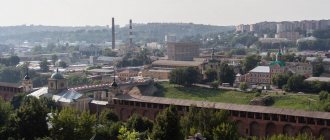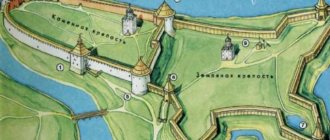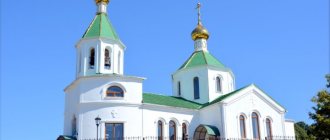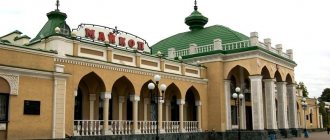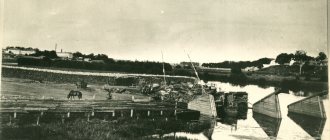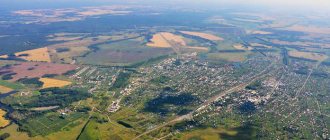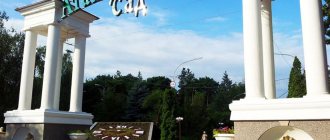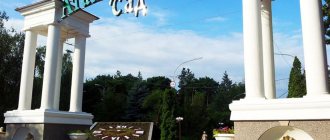I visited Smolensk for the first time in September several years ago as part of a four-day tour. But of these four days, only one was allotted to Smolensk itself, so we looked at the city at a waltz pace, covering only the main attractions. But I felt that there was some unsaidness between me and this city, so I decided to go to Smolensk on my own. Fortunately, I found good company in the person of a friend who was ready for anything except a hunger strike; a date was chosen and train tickets were purchased. While we were on the train, I told my friend about how I visited Smolensk for the first time.
Smolensk
Smolensk
Attractions
Smolensk is the western border of Russia, which more than once or twice took upon itself the first blows of invaders from Europe, who constantly set their sights on the lands of the Russian state. This is an ancient city with a rich history, which is mentioned in chronicles of the 9th century. The famous route “from the Varangians to the Greeks” passed through it - an important trade artery connecting Scandinavia, the Baltic states, Rus' and Byzantium.
In Smolensk, the sights of the Early Middle Ages and architectural monuments of the New Age have been preserved. Of particular interest are military museums, where you can learn about the city’s glorious military past. The main tourist attraction is the powerful Smolensk Fortress - a once impregnable bastion that reliably defended the borders of the state.
Beautiful houses, green parks and monuments of Smolensk, interesting for tourists, are compactly located in the heart of the city. They create the face of the city and personify its history for a millennium. The Smolensk fortress wall is no exception, the remains of which surround many of these attractions. For the same reason, a specific route in Smolensk is not very important: most places are continuously connected to each other, you can circle around them, looking at more and more new details. Below we will just pay attention to the main points where you must go.
Bolshaya Sovetskaya Street
City of Smolensk (Russia)
Smolensk is an ancient city in western Russia and the center of the region of the same name. It is one of the oldest cities in the country, whose history goes back more than 1,150 years. Smolensk has played a significant role for many centuries, being a kind of key and shield of Moscow. The city, many times destroyed by wars and sieges, has preserved a magnificent historical heritage and many attractions, among which stands out an impressive fortress wall with towers and a whole scattering of ancient churches.
For children
Here you can find information about where to go with your child in Smolensk, what to do with children on weekends or on vacation, what children's play centers operate in the city, where to celebrate a child's birthday and what other entertainment for children there is in Smolensk.
The most popular holiday destinations with children are amusement parks, which are most often located in large shopping centers and have a large number of slot machines, children's labyrinths, a complex of games with animators, 6D cinemas and much more.
During the spring-summer season, amusement parks operate in open areas of Smolensk, touring circuses give performances, and exhibitions of exotic animals and fish take place. There is also a children's cafe in Smolensk, which offers an entertainment program and a menu specifically for children.
Where to go with a child on the weekend in Smolensk
Some of the popular places for having fun are large shopping and entertainment centers. Here you can find both children's entertainment, food stations, etc. For the little ones there are entertainment rooms with a pool of balls, slides, and labyrinths. Here children can run around, have fun and socialize with their peers. In some centers, parents are invited to bring their child to a sculpting, drawing, sand painting, etc. group. As a rule, you can find information about the lessons being held in advance on websites or flyers. With older children you can go to the cinema, play on game simulators, and visit a climbing wall.
Advice: Be careful when visiting the cinema with preschool children. Darkness, loud sound, and 3D glasses can easily scare a child. If this happens, you need to immediately leave the room and distract your child with other activities; do not try to watch the session to the end.
Also, the rating of entertainment for children in Smolensk includes visiting a puppet or musical theater. When going to the theater, you should choose a show that is designed for the age of your child, then he will not get bored and will be able to “master” the script. You can visit the museum of military equipment, planetarium and zoo. In the summer, you should definitely go to the water park, organize sports games at the stadium, and regularly organize health jogs in the park.
What to see in Smolensk in 1 day
A trip to Smolensk is an excellent option for a transit route from Moscow to Belarus. You can stay in Smolensk while traveling by car along the excellent Moscow-Minsk highway, or get to Smolensk by train or Lastochka. And now, you, like the ancient Slavs, are making a stop on the journey “From the Varangians to the Greeks” in Smolensk, an ancient city on the Dnieper. The VisitSmolensk.ru portal offers you several ideas of what to see in Smolensk in 1 day!
1. Walk through the historical center of Smolensk and admire the architecture of European Smolensk. Take a walk along the pedestrian Lenin Street, and then go down Bolshaya Sovetskaya along one of the seven hills on which our city stands.
2. What is a must-see in Smolensk? Of course, the majestic Smolensk Cathedral of the Assumption of the Blessed Virgin Mary. Smolensk Assumption Cathedral is rightfully considered one of the most beautiful cathedrals in Russia! You will be amazed by the huge carved gilded iconostasis of the cathedral. Inside the Assumption Cathedral one of the greatest relics of Russia is kept - the icon of the Mother of God Hodegetria. After visiting the temple, buy some fragrant monastery pastries, go out to the observation deck and feed the pigeons.
3. The second “pearl” of Smolensk sights is, of course, the Smolensk fortress wall. Once upon a time this fortress was the most powerful fortification in Europe! The walls of the Smolensk fortress withstood a three-year siege of the city by the Polish-Lithuanian troops of King Sigismund III! Climb the walls of the medieval fortress and look at the city from above. You can walk along the walls of the “necklace of the Russian land” for free on the “Eastern” section of the fortress wall along Timiryazev Street (ascent near the Eagle Tower). However, you need to be careful there, because... the steep steps are overgrown with grass, bricks are missing in some places, and there are no railings or fences. If you want a safer climb, we recommend that you visit the Thunder Tower, where the “Smolensk - Shield of Russia” museum is open. By the way, next to the Thunder Tower there is a monument to the architect who created the impregnable Smolensk fortress - the architect Fyodor Kon.
4. After visiting the monuments of medieval Smolensk, go to the Lopatinsky Garden: there you can get acquainted with the sights associated with the War of 1812. By the way, did you know that Napoleon Bonaparte himself lived in Smolensk for some time?)
5. Let's take a further journey through the pages of history and turn to the Great Patriotic War. Walk through the Heroes' Memorial Square and remember the names of those thanks to whom we now live in this world. Near the Eternal Flame you will see a bust of Smolensk resident Mikhail Egorov, who, together with Meliton Kantaria, hoisted the Victory Banner over the Reichstag. In the Square of Memory of Heroes you can visit the Museum of the Great Patriotic War, which houses terrible exhibits that serve as a reminder of the cruelty and inhumanity of fascism. For example, gloves made of... human skin!
We recommend reading:
Where to go from Moscow for 1 day
6. You can regain peace of mind by visiting one of the three Smolensk churches of the pre-Mongol period! In the 12th century there was no other city in Rus' that could compare with Smolensk in terms of the pace of temple construction. More than 30 of them were erected. Three have survived to this day: Peter and Paul (1146), John the Evangelist (1173) and Archangel Michael (1194).
7. Take a look at the ceramic workshop “Smolenskaya Izba”. This place is imbued with the spirit of the past. Here you can get acquainted with the traditions of our ancestors, and also try to make a pot or jug using a potter's wheel. Spinning wheels, stove, samovar, handmade ceramics. This place is imbued with the spirit of Russian antiquity!
8. Connoisseurs of beauty will be able to usefully spend time in the Smolensk Art Gallery and admire the unique masterpieces by I.K. Aivazovsky, A.I. Kuindzhi, V.A. Serov, I.E. Repin, K.A. Korovin, A. N. Benois and many other domestic and foreign artists.
9. When you get hungry, we recommend that you opt for the Russky Dvor cafe in Blonie Park. This cafe is decorated in a pseudo-Russian, “cranberry” style: with nesting dolls, carved and painted furniture, samovars and other attributes that will delight all foreigners. For hipsters and lovers of something more relaxed and stylish, we recommend the cafe “Buffet” opposite the CEC named after. Tenisheva or a cozy cafe with the unpronounceable name “Aeblehaven” on Tenisheva Street.
10. What to bring as a souvenir from Smolensk? In addition to classic magnets, plates, and mugs, we recommend that you opt for unique Smolensk souvenirs. We recommend that you definitely purchase: “Vyazemsky gingerbread” in the Lopatinsky Garden park and “Evening Smolensk” balm.
First acquaintance with Smolensk
We spent one of the days of the excursion tour in Smolensk. The walking tour of the historical city center was wonderful, and the presence of a bus made it possible to smooth out all the inconveniences of moving around this very center, and even include three museums in the program. The tour was intense and, despite the fact that we spent the night in the city and had free time after dinner, we did not have the energy to explore the local attractions on our own. In addition, the weather pleased us with only one sunny day, or rather, half a day, and this wonderful time fell on a trip to Novospasskoye. So I remember Smolensk itself as gray and rainy. Add to this the presence of not the best photographic equipment and you will understand that it was necessary to return to this city. However, since spending the night in a Smolensk hotel did not leave a very good feeling, and our guide said that there were only two hotels in the city and the second one was much worse than the one we stayed in, the plan for a repeat tour remained in the plans. Once, on the website of a well-known tour operator, I did not see an offer for a one-day excursion trip to Smolensk. The excursion did not suit me due to the overloaded program, but the idea of a one-day trip to this city settled in my head. To be honest, I wanted to go there in the summer, but while I was looking for company, time, money... In general, everything came together again in the fall. At the end of October. And again I didn’t see the sunny city.
Smolensk
Smolensk
Dnieper embankment
The river embankment in Smolensk is relatively new: it was built for the 1150th anniversary of the city, in 2013. This promenade consists of three levels, which are connected to each other by special passages.
Trees and bushes were planted along the entire Dnieper embankment in Smolensk, excellent flower beds were laid out, benches and lanterns were placed; and, of course, there are playgrounds for children. Another name for the embankment is Vladimirskaya, since a monument to Prince Vladimir is erected on it.
Engelhardt House
st. Glinka, 4
“Go to Edik” - in the slang of local residents it means “to sign.” In the house of chamber cadet Alexander Platonovich Engelhardt, who once held the position of city mayor, there is a Wedding Palace. This exquisite mansion is one of the best examples of Baroque in Smolensk and, perhaps, in the entire region.
The building was built in 1878 by the famous architect Yulian Konoplyansky. Rich stucco molding and lush decoration noticeably distinguish it from the surrounding houses. Inside, the first thing you find is a large lobby with a revived echo; on the right is a pompous, bright hall with many windows, on the left is a cozy winter garden. You'll fall in love with it so much and you won't even notice how you leave the building with a ring on your ring finger.
Lopatinsky Garden
The central city park is named after A.G. Lopatin, who held this high position in the second half of the 19th century. By his order, the park was developed in 1874. Nowadays its area occupies 10 hectares.
The main city park has a rather interesting geographical location, as it is located at the intersection of four streets - Lenin, Karl Marx, Dzerzhinsky and Przhevalsky. Each of them has extraordinary historical value due to the presence of interesting monuments from different historical eras.
On each street there is a special gate, which is the entrance to the territory of Lopatinsky Park. The park's territory is divided according to theme. The historical part is a piece of the fortress wall, a bastion and a dungeon. The entertainment element of the park is presented on the amusement area.
The recreation area is designed in the form of a paradise of nature for family recreation. It includes singing fountains, a pond with waterfowl, and enclosures with funny squirrels. Each of these thematic areas deserves attention, and all in tandem they give positive emotions to their adults and young visitors.
The Lopatinsky Garden has many different attractions for children of any age, starting from six years old. There is a ropes course with several trails designed for different ages.
On the pond near the Bubleyki tower, water catamarans are available for rent. In the park at any time you can admire the beautiful swans, and on the way to the Lopatinsky Garden, in the fountain near the bust of A.S. Pushkin, you can look at live fish.
A little history
The history of the city began in 863. According to one legend, Smolensk was founded by the military leader Smolich. According to another, the city got its name thanks to the Smolka River crossing it or the Smoligov well, located on the territory of Smolensk. They also remember the pine forests closest to the city. Pines were a source of resin, which city residents sold in markets. By the way, modern Smolesk is quite green, it’s nice to walk.
In the Ustyug Chronicle, Smolensk was first mentioned in 863. In 882, the Prophetic Oleg installed his governors from the Rurik dynasty in the city. The dynasty ruled the Smolensk principality until 1127, when Rostislav, the son of Mstislav the Great, was proclaimed prince. In the 13th century A great battle took place with the Mongol-Tatars, during which the great warrior Mercury gained fame. Subsequently, Mercury was recognized as the heavenly patron of the Smolensk region. The Battle of Smolensk was of great importance for the further course of history. The Mongol-Tatar hordes never reached Europe, because the Smolensk people stood in their way. The fate of Smolensk was largely determined by its location - between the Principality of Lithuania and Moscow. Because of this, frequent conflicts and clashes arose. In the 15th century the city went to Lithuania. But already at the beginning of the 16th, the Smolensk people again joined Russia. To secure the city, the king ordered the construction of an impregnable fortress.
The defensive structures were built over several years and determined the appearance of the city for many centuries. To this day, about 3.5 km of the fortress wall and 18 towers have remained undestroyed.
The fortress withstood a siege by Polish troops in 1609-1611, which lasted 20 months. The Poles managed to break through the wall only thanks to a traitor from among the Smolensk people. After some time, an attempt was made to return the city. In 1632, the city was besieged by soldiers led by Shein. The blockade continued for a year, but Shein's wars had to surrender. Only 43 years later, Smolensk was returned to Russia. In the 17th-18th centuries. The city is undergoing rapid development. Smolensk is turning into a major center of trade and crafts.
Napoleon's military actions caused enormous damage to the city. During a fierce battle, the walls of the fortress were defended by 2 armies: Barclay de Tolly and Bagration. The French tried with all their might to break through the defense, but they failed. The city burned three times, but survived. In the 19th-20th centuries. active construction is underway. During the Second World War, Hitler's troops struck Smolensk. Already in July, the first bombs were dropped on the streets, and in September the enemy occupied the territory of the city. It was possible to drive out the uninvited guests only in 1943. Today, Smolensk bears the title “Hero City” and is developing, carefully preserving historical monuments and erecting new buildings and structures.
Readovsky Park
Readovsky Park
This landscaped area is located on the banks of the Yasennaya River, where before the revolution there was a country estate of the Smolensk nobles Readov. The beginning of this ancient family was laid by a native of England under Peter I. The Readov estate was located near Smolensk, surrounded by gardens and copses. After the Great Patriotic War, this territory was occupied by Zelenstroy, and in 1960 the Readovsky Forest Park was created here.
It was in those years that mass planting of trees began, most of which were deciduous trees. Today this place attracts residents and visitors of the city not only with its convenient location. On the territory of the forest park, the Mound of Immortality was erected in memory of the residents who died during the Great Patriotic War. In the Readovsky Forest Park you can ride bicycles in summer, and skiing in winter. Bicycles, skis and roller skates can be rented here.
Where to sleep
The best (according to reviews on Booking.com) hotel in the city, West Hotel, is located on the outskirts of the city, surrounded by gas stations and car dealerships. For 1,700 ₽ you will get the service and design of a good chain hotel of the Ibis or Best Western level. Breakfast is better than the standardized buffet at the chain stores, and is more reminiscent of a hearty breakfast like grandma's. On the ground floor of the hotel there is Pyaterochka.
You can spend the night at the Aurora Hotel, which took 69th place in the list of “100 ugliest buildings in Russia” by urbanist Varlamov.
Budget travelers stay in Pichugin Hall or Travel hostels - 350–450 rubles per bed.
Extremely budget-minded or stubborn hikers can put up a tent on the banks of the Dnieper near the Dzerzhinsky Bridge. At this point on the maps.me maps there is a mark: “We spent the night with a tent on the grass.” At least two people checked the place for suitability for such an overnight stay.
Monument to the Heroes of 1812
The best monument in Smolensk, in my opinion, is the Monument to the Heroes of 1812. Monument with eagles, as the Smolensk people call it. The foundation stone for this monument was laid on August 6, 1912, on the centenary of the war with Napoleon.
The grand opening took place on September 10, 1913. The monument was erected according to the design of sculptor S. R. Nadolsky and engineer Shutsman.
A warrior in medieval armor, with a drawn sword in his hand, is advancing along the ledges of the rock, towards its top. He personifies the French invaders. At the top of the rock there is a nest and two eagles. The eagles symbolize the two Russian armies united in Smolensk. It is impossible to describe in words, you have to see it with your own eyes, believe me, a breathtaking sight.
On the eastern side of the rock, at its base, is attached a bronze map of the European part of Russia with the text: “Grateful Russia to the heroes of 1812.”
Memorial "Mound of Immortality"
Address: Readovsky Park. Transport stop "Chernyakhovskogo Street".
During the Great Patriotic War, Smolensk was again destined for the role of the main defender of Moscow. The heroic defense of the city for two months, from July 10 to September 10, 1941, did not allow Hitler and his generals to implement the Barbarossa plan. A terrible price had to be paid for this. More than 700 thousand Soviet soldiers gave their lives so that the offensive of Army Group Center was suspended, which made it possible to gather forces for the defense of Moscow.
To celebrate the 27th anniversary of the liberation of Smolensk from the Nazis, a memorial was opened in the city in memory of its defenders. A stele rises above the Kurgan, which has the shape of a truncated pyramid. On the pages of an 11-meter-long open book, the dates of the beginning and end of the terrible war are stamped out of concrete, below which are carved bas-reliefs of a worker, a partisan, a warrior and a mother with a child.
Heroes' Memorial Square
Near the fortress wall in the park in memory of heroes, the burial places of the fallen defenders of Smolensk.
Here, near the fortress wall, people are buried who gave their lives serving the people and the Fatherland. There are only two such memorials in Russia: the first is the well-known burial site on Red Square in Moscow, the second is in the hero city of Smolensk.
Burials of dead Soviet soldiers near the fortress wall began after the liberation of Smolensk and part of the region from the Nazi invaders. There are 39 graves along the fortress wall, including 4 memorial graves of Heroes of the Soviet Union:
- guard sergeant Oktyabrskaya Maria Vasilievna (08/16/1902 - 03/15/1944)
- partisan Kurylenko, Vladimir Timofeevich (12/25/24 - 05/14/1942)
- Colonel Gubenko, Anton Alekseevich (02/12/1908 - 03/31/1939)
- guard senior sergeant Mikhail Alekseevich Egorov (05/05/1923 - 06/20/1975)
Streets in Smolensk are named after them.
The Eternal Flame complex is located in the center of the square opposite the burial grounds. On September 28, 1968, during the celebration of the 25th anniversary of the liberation of the Smolensk region from the fascist invaders, the Eternal Flame was lit in the Memorial Park of Heroes. He was delivered by armored personnel carrier from Moscow from the Tomb of the Unknown Soldier.
The Park in Memory of Heroes acquired its modern appearance in 1975, when reconstruction was carried out and a granite stele was installed with the words of N. I. Rylenkov:
Comrade, remember: the faithful sons of Your Fatherland are buried here, That they did not spare their lives for it. They fulfilled their duty in full. Read and repeat their names And how they learn to serve the Fatherland.
On September 24, 2006, the Alley of Hero Cities was opened in the park. 13 concrete obelisks are installed in a row along the fortress wall. On each of them there is a Gold Star medal and the name of the hero city. Inside the obelisks are capsules with soil from the battle sites in the hero cities.
Why did I title my post “Sights in one day”? Because all these memorable places in Smolensk are located in the historical center of the city and within walking distance of each other. And I would begin my acquaintance with the Smolensk region in the morning from the international memorial “Katyn”, so that in the afternoon I could return to the city and finish sightseeing, which I described above.
Smolensk Kremlin
Tall and powerful, intriguing and striking in their age are the walls of the Smolensk fortress, built at the end of the 16th - beginning of the 17th centuries. made of red brick. Without exception, every visitor is in a hurry to explore them. Tourists walk along the walls, examining the first masonry, look inside and conquer the upper tier, enjoying the view and their personal involvement in their existence.
The stone wall was erected on the site of a wooden one from the time of Ivan the Terrible, whose defensive capabilities were losing strength. Re-fortifications were carried out under Peter I. The walls protected Smolensk from the Polish kings, Napoleon and fascist invaders, as a result of which half of more than six kilometers has been preserved, represented today in sections of different lengths. In this regard, the fascinating legend about the curse of Boris Godunov, who sends punishment to anyone who dares to destroy the wall, is interesting.
Smolensk fortress wall
Assumption Cathedral in Smolensk
The Cathedral of the Assumption of the Blessed Virgin Mary is the main shrine of Smolensk, towering above the city. The turquoise five-domed temple has an ancient history; its location is even more archaic - Cathedral Hill, on which the remains of ancient settlements were found.
We recommend reading:
Sights of Voronezh
The first version of the cathedral was erected in 1101 by Vladimir Monomakh, and a monument was erected nearby in his honor. He also brought the icon of the Mother of God Hodegetria, inherited from his mother, which received the name of Smolensk. The entire central part of the city was then concentrated around the cathedral on the mountain. At the beginning of the 17th century. it was blown up during the siege by the Poles due to the explosives stored in it, and began to be rebuilt only at the end of the century, receiving its final appearance only by the 1770s. It is surprising that neither Napoleon in 1812, nor the leadership of the German troops during the Second World War encroached on its beauty, but gave orders for protection.
Assumption Cathedral
Sightseeing tour of Smolensk
We met with the group near the station, boarded a bus and went on a sightseeing tour of Smolensk. It was sad to hear from the guide - we won’t have time to do anything, we won’t see anything, we have very little time. In general, everything is clear. The company in a large bus gathered without random people: intelligent and pleasant people, which was especially pleasing. But the guide! How can you assign such a guide to such a specific excursion that inexperienced travelers will not go on! Dates, numbers, a list of buildings that we pass by... classics of the genre for an excursion without a soul. Not modern, not interesting, boring... I love charismatic guides who tell stories, captivate and work with the audience, but boring Wikipedia reading into a microphone is terrible. As you understand, we ended up on the same Wikipedia broadcast.
The bus made its first stop near one of the pride of Smolensk - a pre-Mongol temple.
The first of the pre-Mongol buildings that we saw was the Temple of Peter and Paul, created in the 12th century. The temple survived the transfer to a Catholic church and returned back to Orthodoxy. In the 18th century a major reconstruction of the building united it with the Church of the Great Martyr Barbara. During the hostilities with Napoleon, the temple suffered many trials, but a year later it was completely restored. In 1935 the temple was closed, and in 1943 it was damaged during the fierce battles for the liberation of Smolensk. Only in the 60s. last century, the exterior and interior decoration were restored by the architect Baranovsky. The true purpose of the temple was returned only in the 90s, after which services were resumed. The Temple of St. John the Evangelist is also a pre-Mongol building. The building was erected in the 12th century. At that time, the temple stood out for its rich decoration with gold and enamel. The fate of a cultural heritage site is complex and sometimes difficult. The temple had to be a Catholic church until it was returned to Orthodox status. Major reconstruction in the 18th century made it possible to raise the floor and replace the pillars and vaults with new ones. The structure withstood the French invasion and was restored after being plundered. What the French could not do, the Soviet government managed to complete. The interior was completely looted and used for building materials. During the Second World War, many buildings were destroyed. Until the return of his diocese, the temple was not used for its intended purpose. We listened to a set of historical facts, went inside and continued the tour on the bus at a waltz pace. The program from Magput stated two pre-Mongol temples, but we saw only one. I was amazed that they didn’t show us the temple of the Smolensk architectural school. Except, I can’t call it blasphemy.
Trench Church
The temple is located in the eastern part of Smolensk. The church was built in 1776, and received its name in honor of the grandiose battle led by General Shein.
Trench Church
Of particular value for religious tourists is located inside the premises - an ancient icon painted in the 10th-11th centuries. However, the presented version is a copy of the legendary handwritten sample that was stolen during the Civil War. Other travelers will appreciate the luxurious baroque architectural style of the church.
- Address: st. Okopnaya, 1.
- Opening hours: daily from 9:00 to 17:30.
- Cost of visiting: free.
Blonje Park
Blonye Park or the garden named after M.I. Glinka is another corner of nature in the very center of Smolensk, visited by many like the Lopatinsky Garden. It was founded earlier than its closest neighbor, in 1830 by Governor N. Khmelnitsky at the instigation of Empress Catherine II, who noted the unkemptness of the city.
A small but neat garden with symmetrical paths and a fountain has its own attractions. Bronze deer and lion appeared here in the post-war period and are considered trophies from the dacha of a German military leader. The second name for the garden at the end of the 19th century. gave the first monument in Russia to the composer M. I. Glinka, who was about to wave his baton. Pay attention to the fence, made in the form of a staff with the melodies of his most famous operas and romances, and the position of the composer’s figure, facing the Smolensk Philharmonic.
Monument to M.I. Glinke in the Blonje Garden
Bronze deer on Blonie
The bronze deer installed in the Blonier garden is famous for its interesting history. The sculpture was made by Richard Friese in 1909 for Kaiser Wilhelm II. In 1945, the sculpture was discovered at the dacha of Goering, known for his passion for collecting rarities, by Soviet soldiers, and in the same 1945, the deer came to Smolensk in a large box as a gift from the winners to Smolensk children.
Everyone's favorite of Smolensk is rubbed to a shine by the hands of students for good luck. Next to the deer are several more bronze figurines of the same origin.
Blonje Garden is a very cozy place to relax on a hot day or damp autumn weather. There are always a lot of people around the fountain here, and the “Russian Court” cafe located in the park attracts visitors not only with its varied Russian cuisine and inexpensive prices, but also with the fabulous design of the territory.
Where does this “French” name come from in the center of one of the oldest Russian cities?
Blonier has nothing to do with Napoleon or the Polish occupation. It originally sounded like “bolonia” and meant pastures, meadows for grazing livestock, because this area in ancient times was a suburb outside the fortress wall, and now it has become the center of the city.
Stories, reviews and tourist routes
Tourists often go to Smolensk for two days. Weekends for travelers from surrounding cities and Moscow are an excellent opportunity to get acquainted with the rich historical heritage, calmly stroll along the ancient walls of the fortress, city streets and see all the sights. Walking routes may be different, although their content is usually the same. It necessarily includes an inspection of the fortress walls, Bolshaya Sovetskaya Street, Lopatinsky Garden and Blonye Park, various military monuments and the study of historical museums.
A visit to Smolensk is often integrated into a long trip along the western borders of the country - the Bryansk, Pskov and Leningrad regions, and also conveniently fits on the route to further travel to Belarus, Lithuania or Latvia. There are many hotels of different levels in the city, and its guests do not miss the opportunity to spend the night in comfort.
Site users share their impressions of the trip in stories:
- “That’s where the Krivichi sit” from Victor Bashkir
- “Smolensk is the shield of Russia! Part 1" and "Smolensk - Shield of Russia! Part 2" from Daria In Tourism
- “Smolensk weekend” from Evgeniy
- as well as photo albums - “Smolensk. City Day 09/25–26/2020” from Marina
- Photo album “How I was a Smolenka for 2 days” from Svetlana Aubekerova
All tourist reviews about Smolensk on Tourist. RU
More information about the history, transport, weather and hotels in the city can be found on the Smolensk page, as well as tips on how to get there.
Monument to A. Tvardovsky and V. Terkin Photo: © Victor Bashkir
Tushemlya settlement
In the Pochinkovsky district, not far from the Tushemlya river, there is one interesting place. The settlement, which claims to be the first settlement of the Smolensk region, is the main competitor of Gnezdovo.
Historians and archaeologists are inclined to believe that the first people, the predecessors of the Krivichi Slavs, appeared here in the 18th-14th centuries BC. e. That is, long before the Gnezdovo culture. But most importantly, the peoples living on the banks of Tushemli were distinguished by their originality.
Among the finds discovered on the territory of the settlement, the most common are tools made of iron. This suggests that the residents of Tushemli were well acquainted with blacksmithing. Most of the population was engaged in cattle breeding and agriculture.
An excursion is an excursion, and coffee is on schedule. Coffee house Donna Clara
Having left the station territory and examined the Peter and Paul Church, we moved along Kashena Street. And we weren’t looking for landmarks, but… McDonald’s. My companion really wanted coffee, and it didn’t hurt to just have something to eat, and it was quite far from the Russian Dvor cafe, which I definitely wanted to visit. At the same time, I remembered the guide’s story that Smolensk residents love their catering and do not allow competitors into the city. McDonald's was able to open only one restaurant in Smolensk. Having reached the most famous fast food, located on Kolkhoznaya Square, with the help of local residents, we... made a choice in favor of a local cafe. The fact is that on the road, right in front of us, there were a Domino pizza cafe and a Donna Clara coffee shop (later it turned out that this is like one establishment, only if you want to eat, you go to the left, and if you just want coffee with a bun, then to the right ). Deciding that we wanted more coffee, we went into the coffee shop and opened our mouths in admiration. There was not a single millimeter here that was not decorated with something.
coffee shop Donna Clara
coffee shop Donna Clara
We were pleasantly surprised by the prices. This tray of food cost only 200 rubles. And personally, I overate.
Food on a tray
Food on a tray
We really liked it and stayed here because... I wanted to photograph everything, everything, everything. The fly in the ointment in this case is, sorry, one toilet stall for everyone, and not the best view from the window. Still, Kolkhoznaya Square is not the most visually pleasing part of Smolensk.
Bolshaya Sovetskaya Street
Bolshaya Sovetskaya Street
Although this street in Smolensk is not the oldest, it is nevertheless considered one of the most beautiful and popular city attractions. It stretches from the Dnieper bank through the historical center of Smolensk, past the Cathedral Mountain with the Assumption Cathedral. It was on this street, which was formerly called Trinity Highway and Bolshaya Blagoveshchenskaya Street, that wealthy townspeople built their mansions and apartment buildings.
Today, almost every house that has survived on Bolshaya Sovetskaya Street is an architectural “pearl” worthy of special attention. Most of the residential and administrative buildings facing the main street are recognized as architectural and historical monuments. Some of the buildings destroyed during the war were carefully restored to their original form using photographs and archival documents.
Address: Bolshaya Sovetskaya Street, Smolensk, Russia.
Readovsky Park, Valutina Mountain
In addition to everything described above, the following places may be no less interesting. However, you need to get to them separately.
Readovsky Park is a large forested area on the southwestern outskirts of the city, a good place for nature walks and sports. Its landmark is the Mound of Immortality, dedicated to those who died during the war of 1941-1945. The same events formed the basis of the “Grieving Mother” monument, installed against the backdrop of the memorial and mass grave of underground fighters and partisans.
Valutina Gora is an observation deck with a monument to soldiers of 1632-1634. at the eastern edge. From the high hill, which took part in the battles of 1812 with the French, a wide panorama of Smolensk opens up.
Memorial on Valutina Mountain
Museum "In the World of Fairy Tales"
If you walk from the Assumption Cathedral along Bolshaya Sovetskaya and turn right onto Lenin Street, you can come to the museum “In the World of Fairy Tales”. Children will really like the exhibits in its exhibition halls. The exhibitions here present scenes from famous Pushkin and folk tales. The most striking exhibits: products of the Moscow master Gavrila Ustinov, a painted chest from the mid-19th century, a Vologda sled.
Museum "In the World of Fairy Tales"
Address: Smolensk, st. Lenin 15.
Opening hours: Tue-Sun from 10.00 to 18.00, closed on Monday.
If you go further along Lenin Street, you can get to the Historical Museum of Smolensk.
Talashkino
18 km south of Smolensk is the village of Talashkino, which has the status of a historical and artistic reserve. Previously, there was an estate of Princess Maria Tenisheva, who is famous for her charity. On the outskirts of the estate, the Flenovo farmstead was equipped with it, where peasant children learned to read and write. In general, the main goal of her life was the revival of peasant artistic craft. In this regard, numerous educational and artistic workshops appeared in the village, like mushrooms after rain. From 1893 to 1914, Talashkino was Abramtsev’s competitor in terms of artistic life; many sculptors, artists and other bohemians visited here.
Museum of the Smolensk region during the Great Patriotic War 1941-1945
This museum is one of the most visited in the city. It contains exhibits from the period of occupation of the Smolensk region, the partisan movement, the liberation of Smolensk, and the participation of Smolensk residents in the liberation of Eastern Europe from the Nazis.
Visitors are interested in the belongings of participants in the battles for Smolensk and Vyazma, weapons of the Nazis and soldiers of the Red Army, uniforms, awards and trophies of defeated Nazi Germany.
Museum of the Smolensk region during the Great Patriotic War
Near the museum there is an exhibition of military equipment: the legendary Katyusha, T-34 and IS-2 tanks, the ZIS-5 car, the Shilka self-propelled anti-aircraft gun, the MiG-23M fighter, etc.
Address: Smolensk, st. Dzerzhinsky, 10 building 1. Opening hours: daily from 10.00 to 19.00.
It is impossible to see all the sights of Smolensk in one day. Over the entire history of the city of 1150 years, many architectural monuments were erected and rebuilt here. In the last century, museums of various directions were opened in Smolensk: art, blacksmithing, history, about the period of the Great Patriotic War, “Smolensk Flax” and others.
Sources:
Author of the publication
offline for 3 months

